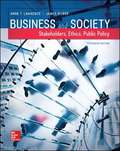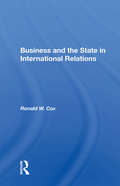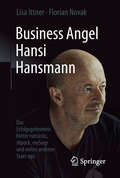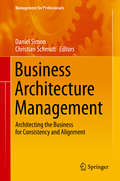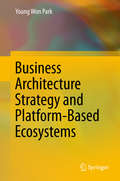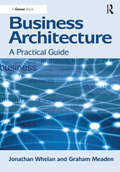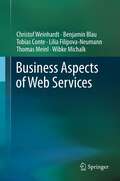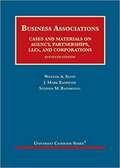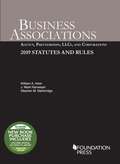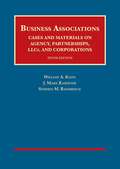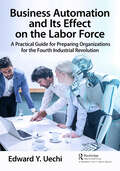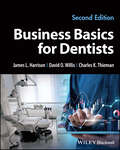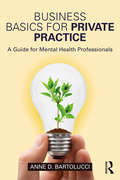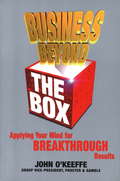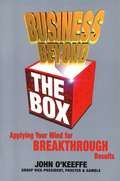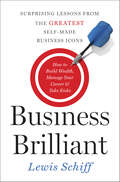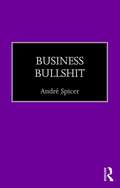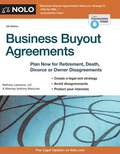- Table View
- List View
Business And Politics In Peru: The State And The National Bourgeoisie
by Francisco DurandAn analysis of business/government relations in Peru which focuses on the complex and changing linkages between the social class that controls key material resources and the State. The author argues that, despite its traditional weakness, the national bourgeoisie has become a key political actor.
Business And Society: A Strategic Approach to Social Responsibility and Ethics
by Linda Ferrell O. C. Ferrell ThorneA brief alternative to its competitors, Business and Society combines 12 chapters with 12 cases to offer a strategic approach to social responsibility. <P><P>Streamlined coverage of key topics allows undergraduate students and MBA majors to focus on only what they need to prepare for in the real business world. <P><P>Concise chapter content allows instructors to introduce outside resources into their course, such as readings, cases, and projects that enhance students' understanding of the material. Students will gain the background knowledge, skills, and insight necessary to analyze how organizations achieve both social and financial performance benefits through social responsibility.
Business And Society: Stakeholders, Ethics, Public Policy
by Anne T. Lawrence James WeberIn a world economy that is becoming increasingly integrated and interdependent, the relationship between business and society is becoming ever more complex. The globalization of business, the emergence of civil society organizations in many nations, and new government regulations and international agreements have significantly altered the job of managers and the nature of strategic decision making within the firm. The Fifteenth Edition of Business and Society: Stakeholders, Ethics, Public Policy draws on the latest research to address the challenges facing business organizations and their stakeholders. The text builds on its legacy of market leadership by reexamining central issues.
Business And The State In International Relations
by Ronald W CoxChallenging the traditional notion that state officials act autonomously in formulating and implementing international policy, the contributors to this volume argue that the influence of organized business groups has been consistently underestimated in recent decades. Each uses a "business conflict" model of state-society relations as a new paradig
Business Angel Hansi Hansmann: Das Erfolgsgeheimnis hinter runtastic, shpock, mySugr und vielen anderen Start-ups
by Lisa Ittner Florian NovakWenn ein Business Angel in ein Start-up involviert ist, steigt die Erfolgswahrscheinlichkeit. Der erfolgreiche Österreicher Hansi Hansmann gilt als empathischer Zahlenmensch, der gerne gewinnt und nur mit Menschen arbeitet, die er auch mag. Dieses Buch gewährt Einblicke in sein Wesen und Denken, seine Auswahlkriterien, seine Rolle als Berater und Förderer. Er selbst kommt ebenso im Interview zu Wort wie seine Gründerfreunde. Der Leser erfährt im Klartext, worauf es ihm und den Gründern wirklich ankommt – um die Prinzipien und Einsichten für sich selbst zu adaptieren. Eine frische, inspirierende und gewinnbringende Lektüre für Investoren, Gründer und alle, die mehr über Hansmanns Erfolgsgeheimnis wissen wollen: Mensch bleiben und nachhaltig erfolgreich sein ist kein Widerspruch, sondern der entscheidende Schlüssel.
Business Architecture Management: Architecting the Business for Consistency and Alignment (Management for Professionals)
by Daniel Simon Christian SchmidtThis book presents a comprehensive overview of enterprise architecture management with a specific focus on the business aspects. While recent approaches to enterprise architecture management have dealt mainly with aspects of information technology, this book covers all areas of business architecture from business motivation and models to business execution. The book provides examples of how architectural thinking can be applied in these areas, thus combining different perspectives into a consistent whole. In-depth experiences from end-user organizations help readers to understand the abstract concepts of business architecture management and to form blueprints for their own professional approach. Business architecture professionals, researchers, and others working in the field of strategic business management will benefit from this comprehensive volume and its hands-on examples of successful business architecture management practices.
Business Architecture Strategy and Platform-Based Ecosystems
by Young Won ParkThis book provides a framework and real case analyses concerning business architecture strategy and platform-based ecosystems. Firstly, the book introduces a framework of business architecture strategy and suggests an engineering process that employs a business architecture analysis system in which the various business best-practices information technology (IT) tools are integrated into an interface. More specifically, this architecture analysis provides the means to realize two essential features: a strategy that allows global firms to sense changing market needs, and a tool that combines mechanical engineering with electronics and software IT tools. Secondly, the book discusses platform-based ecosystems. Crucial issues for today's firms are associated with value creation through their platform and ecosystem framework. With a major emphasis on modular product architecture, US firms have focused heavily on platform development in modular industries. Their base is operation system (OS) software, so that IT firms in general focus on software capabilities--and digital control in particular. In contrast, the advantage for Japanese firms is not digital but analog control. Without any drastic changes in their industry practices, Japanese firms are likely to sustain their analog platform advantage. The book subsequently puts forward a holistic view through the connection of business architecture strategy and platform-based ecosystems. The theoretical framework and case illustrations are especially useful to firms involved in a variety of industries that must respond to the turbulent environmental changes of the digital era. Most of the cases target not only Japanese firms but also many other global firms. Readers are systematically shown how to balance technological competence and customer competence by using the framework of business architecture strategy and platform-based ecosystems.
Business Architecture: A Practical Guide
by Jonathan Whelan Graham MeadenOrganizations today exist in an environment of unprecedented change. They do so against a backdrop of a global, competitive marketplace, the fast-paced enablement of technology, amplified regulation and accelerating organizational complexity. Many organizations are addressing change in a sub-optimal way and they are operating without a clear view of where their operational risks lie. It is these dynamics that are leading organizations to recognise and embrace Business Architecture. Despite this environment, Business Architecture can be a difficult ’sell’ - it is often perceived to be abstract and lacking in tangible delivery. To succeed, Business Architecture must be pragmatic and, to be sustainable, it must focus on achieving long-term value and, at the same time, recognise the shorter-term tactical needs of the organisation. With these challenges in mind, this book provides a practical guide on how to employ Business Architecture and how to build a balanced proposition that delivers value to a broad range of stakeholders. As the book states, Business Architecture should not be practised in isolation, nor should it be thought of as a one-off process; it needs to be woven into the fabric of the organization. And so the authors illustrate the opportunities for weaving the Business Architecture Practice into this fabric through the various stakeholders and life cycles that exist, both formally and informally, within an organization. Whilst recognizing best practice, this book explores a new, inspirational level of Business Architecture whilst acknowledging that the best way to realize the vision is one step at a time.
Business Aspects of Web Services
by Benjamin Blau Christof Weinhardt Wibke Michalk Lilia Filipova-Neumann Thomas Meinl Tobias ConteDriven by maturing Web service technologies and the wide acceptance of the service-oriented architecture paradigm, the software industry's traditional business models and strategies have begun to change: software vendors are turning into service providers. In addition, in the Web service market, a multitude of small and highly specialized providers offer modular services of almost any kind and economic value is created through the interplay of various distributed service providers that jointly contribute to form individualized and integrated solutions. This trend can be optimally catalyzed by universally accessible service orchestration platforms - service value networks (SVNs) - which are the underlying organizational form of the coordination mechanisms presented in this book. Here, the authors focus on providing comprehensive business-oriented insights into today's trends and challenges that stem from the transition to a service-led economy. They investigate current and future Web service business models and provide a framework for Web service value networks. Pricing mechanism basics are introduced and applied to the specific area of SVNs. Strategies for platform providers are analyzed from the viewpoint of a single provider, and so are pricing mechanisms in service value networks which are optimal from a network perspective. The extended concept of pricing Web service derivatives is also illustrated. The presentation concludes with a vision of how Web service markets in the future could be structured and what further developments can be expected to happen. This book will be of interest to researchers in business development and practitioners such as managers of SMEs in the service sector, as well as computer scientists familiar with Web technologies. The book's comprehensive content provides readers with a thorough understanding of the organizational, economic and technical implications of dealing with Web services as the nucleus of modern business models, which can be applied to Web services in general and Web service value networks specifically..
Business Associations, Cases, and Materials on Agency, Partnerships, LLCs, and Corporations (University Casebook)
by William Klein J. Ramseyer Stephen BainbridgeWith the prior edition of this concise, up-to-date casebook having been adopted at over 100 law schools, the eleventh edition (formerly Klein, Ramseyer, and Bainbridge's Business Associations casebook) continues to provide a comprehensive overview of agency, partnership, and corporation law. It also continues to emphasize five basic editorial principles: Cases edited ruthlessly to produce a readable and concise result. Facts matter, so they are included in all their potential ambiguity. Bring a planner’s perspective to the table through extensive use of transactionally-oriented problems. It’s a casebook not a treatise. No long, stultifying textual passages. Provide the cases and let the individual teacher use them as he or she sees fit. Try to find cases that are fun to teach. Great facts or a clever analysis are always given first priority in case selection.
Business Associations: Agency, Partnerships, LLCs, and Corporations and 2019 Statutes and Rules
by William Klein Stephen Bainbridge Mark RamseyerThis statutory supplement includes statutes and rules relevant to all business entities. It is suitable for use with all textbooks and casebooks for such courses. It includes all updates to the statutes and rules.
Business Associations: Cases And Materials On Agency, Partnerships, LLCs, And Corporations (University Casebook)
by William Klein J. Ramseyer Stephen BainbridgeWith the prior edition of this concise, up-to-date casebook having been adopted at over 100 law schools, the tenth edition preserves the authors' tradition of providing a comprehensive overview of agency, partnership, and corporation law. It also continues to emphasize five basic editorial principles: Cases edited ruthlessly to produce a readable and concise result. Facts matter, so they are included in all their potential ambiguity. Bring a planner's perspective to the table through extensive use of transactionally-oriented problems. It's a casebook not a treatise. No long, stultifying textual passages. Provide the cases and let the individual teacher use them as he or she sees fit. Try to find cases that are fun to teach. Great facts or a clever analysis are always given first priority in case selection.
Business Associations: Cases and Materials on Agency, Partnerships, and Corporations (Eighth Edition)
by Stephen M. Bainbridge William A. Klein J. Mark RamseyerWith the prior edition of this concise, up-to-date casebook having been adopted at over 100 law schools, the eighth edition preserves the authors' tradition of providing a comprehensive overview of agency, partnership, and corporation law. It also continues to emphasize six basic editorial principles: Be lean but not mean, cases edited ruthlessly to produce a readable and concise result. Facts matter, so they are included in all their potential ambiguity. Bring a planner's perspective to the table through extensive use of transactionally-oriented problems. It's a casebook not a treatise. No long, stultifying textual passages. Provide the cases and let the individual teacher use them as he or she sees fit. Try to find cases that are fun to teach. Great facts or a clever analysis are always given first priority in case selection. Provide a teachers' manual that goes into great depth, with analysis of every case and, whenever applicable, offering the disparate views of each author. An exhaustive teachers' manual extensively discusses every case and provides answers to every question in the text. One feature that many adopters find especially helpful is that all three editors give their own approach to the cases, showing the different ways in which the same case can be taught. Annually updated PowerPoint slides cover almost all sections of the book and feature an extensive use of data, graphics, and photos.
Business Automation and Its Effect on the Labor Force: A Practical Guide for Preparing Organizations for the Fourth Industrial Revolution
by Edward UechiBusiness Automation and Its Effect on the Labor Force informs business managers on new technologies that can make their industries more efficient. This book provides a primer on quantum computing, artificial intelligence, robotics, and sensors. As a business management book, managers can start planning for the future. The author predicts when the advanced systems would be ready to use. Getting a clearer picture of what is on the horizon, business managers can determine how many workers and machines will be needed. Managers will learn how to calculate the optimal mix of workers and machines. Key Book Highlights Covering labor and technology in agriculture, manufacturing, construction, transportation, hospitality, health care, office administration, and education. A review of the evolution of systems, machines, and devices from the past to the present, and where the latest advancement is headed. A visual timeline showing when new systems and machines would be available for eight industries in the next 25 years. Succinct descriptions of eliminated jobs, retained jobs, and new roles for workers. A simplified method to calculate the costs of operations, allowing business managers to compare human productivity against machine productivity. Labor market information in context of technological innovation for state workforce agencies and local workforce development boards. Lists of occupations with Standard Occupational Classification (SOC) codes for labor economists, workforce development specialists, and job seekers.
Business Basics for Dentists
by David O. Willis James L. Harrison Charles K. ThiemanBusiness Basics for Dentists Concise yet comprehensive overview of business management principles tailored for dental practices, with strategies to apply the core concepts to achieve success Rather than presenting a rote checklist of steps for success, Business Basics for Dentists, Second Edition describes business, economic, marketing, and management principles and explains how to apply them to dental practice. Now fully updated throughout, this book provides the essential elements of a business course—management principles, economics, business finance, and financial analysis—without getting bogged down in too much detail. Dental students and new practitioners will learn how to use the core strategic and operational business philosophies to develop an effective dental practice. The business management principles are related to various aspects of running and managing a dental practice, including office communications, billing, inventory, and marketing. All aspects of practice transition are approached, including career opportunities, buying a practice, starting a new practice, multi-practitioner arrangements, practice valuation, and planning and developing a practice. The book also covers personal financial planning to ensure that the dentist is also planning for their finances and retirement beyond the bounds of the practice. Business Basics for Dentists, Second Edition covers: Personal money management and insurance needs, reducing the personal tax burden, estate planning, and securing financing Business entities, basic economics, the legal environment of the dental practice, financial statements, and business taxes and tax planning Management principles, planning the dental practice, financial analysis, and control in the dental office, maintaining production and collections, and gaining case acceptance Generating patients for the practice, controlling costs, promoting staff effectiveness, and maintaining daily operations Focusing on the transition period from a dental student, through corporate employee, to ownership, Business Basics for Dentists is a valuable tool for dental students and professionals seeking to further their career path through actionable advice from experts in the field.
Business Basics for Private Practice: A Guide for Mental Health Professionals
by Anne D. BartolucciBusiness Basics for Private Practice is a step-by-step guide to developing a successful practice from initial conceptualization and business plan to future growth for the true entrepreneur. Dr. Bartolucci draws from interviews with fellow mental health practitioners and experts in business-related fields to make even the most intimidating parts of practice easy to understand. Business Basics is written to give the feel of mentorship, and the author talks about lessons learned the hard way. She’s also included checklists and worksheets to help you stay organized and ready to meet the challenges of opening a private practice.
Business Basics: Skills that Gen Y's Need to Succeed at Work
by Tamara EricksonAlthough Gen Y's are the best-educated generation yet, there are two skills that are essential to success that you may not have mastered. You must be able to communicate well in writing, using a style that is suitable to business. And you need to understand and comfortably speak the language of finance. Use the tips in this chapter to sharpen those skills and ease your transition into the work world.
Business Battles in the US Energy Sector: Lessons for a Clean Energy Transition (Routledge Studies in Energy Policy)
by Christian DownieThis book is ground breaking in its study of business actors in climate and energy politics. While various studies have demonstrated the influence of business actors across multiple policy domains, this is the first to examine the behaviour of business actors in energy centric industries in the US that will be vital for achieving a clean energy transition, namely the oil, gas, coal, utility, and renewable industries. Drawing on almost 80 interviews with senior energy executives, lobbyists, and policymakers, it asks two central questions: (i) how and why are business actors shaping energy policy contests in the US? And (ii) what are the implications for policymakers? In answering these questions, this book provides new insights about the preferences and strategies of business in the energy sector, and, significantly, it identifies strategies for policymakers seeking to regulate energy in the face of political resistance from incumbent fossil fuel industries. This book will be of particular value to students, scholars, and policymakers working in the fields of energy, climate, and environmental politics, as well as individuals generally interested in the role that business exerts over policy processes.
Business Beyond the Box
by John O'KeeffeBusiness Beyond the Box makes note of the self-imposed limitations each of us places on ourselves unconsciously. With a focus on applying new mindsets and achieving breakthrough results, O'Keeffe suggests working with-rather than within-boundaries. Applicable to both individuals and organizations, Business Beyond the Box will improve readers' ability to innovate.
Business Beyond the Box: Applying Your Mind for Breakthrough Results
by John O'KeeffeBusiness Beyond the Box makes note of the self-imposed limitations each of us places on ourselves unconsciously. With a focus on applying new mindsets and achieving breakthrough results, O'Keeffe suggests working with--rather than within--boundaries. Applicable to both individuals and organizations, Business Beyond the Box will improve readers' ability to innovate.
Business Beyond the Box: Applying Your Mind for Breakthrough Results
by John O'KeeffeBusiness Beyond the Box makes note of the self-imposed limitations each of us places on ourselves unconsciously. With a focus on applying new mindsets and achieving breakthrough results, O'Keeffe suggests working with--rather than within--boundaries. Applicable to both individuals and organizations, Business Beyond the Box will improve readers' ability to innovate.
Business Brilliant: Surprising Lessons from the Greatest Self-Made Business Icons
by Lewis Schiff“Useful insights” about what self-made successes do differently, from the coauthor of The Middle-Class Millionaire (Publishers Weekly).In Business Brilliant, Lewis Schiff combines compelling storytelling with groundbreaking research to reveal what America’s self-made rich already know: It’s synergy, not serendipity, that produces success.He explodes common myths about wealth—and explains how legendary entrepreneurs such as Richard Branson, Suze Orman, Steve Jobs, and Warren Buffett have subscribed to a set of priorities that’s completely different from those of the middle class.Schiff identifies the seven distinct principles practiced by individuals who may or may not be any smarter than the rest of the population, but seem to understand instinctively how money is made. This guide also reveals how these business icons excel in areas of team building, risk management, and leadership development to accumulate their wealth. And he offers a practical four-step program—from choosing one’s livelihood and pinpointing skills to focus on to negotiating job terms and salary—in order to bring upon greater success.“Schiff builds his narrative on solid evidence, including research data comparing and contrasting the self-made person with the usual middle class.” —Booklist
Business Budgets and Accounts: Accounting: Business Budgets And Accounts (Routledge Library Editions: Accounting)
by Harold C. EdeyThis book shows the relevance of accounting methods to the economic and administrative problems of business. The book has been arranged to take the reader through the budgeting procedure of a representative business: demonstrating the relationship between budgets, accounts and the various business activities and showing how budgets and accounts link together the balance sheets at the beginning and end of the year.
Business Bullshit
by André SpicerOur organizations are flooded with empty talk. We are constantly "going forward" to lands of "deliverables", stopping off on the "journey" to "drill down" into "best practice". Being an expert at using management speak has become more important in corporate life than delivering long lasting results. The upshot is that meaningless corporate jargon is killing our organizations. <P><P>In this book, management scholar the author argues we need to call this empty talk what it is: bullshit. The book looks at how organizations have become vast machines for manufacturing, distributing and consuming bullshit. It follows how the meaningless language of management has spread through schools, NGOs, politics and the media. <P><P>Business Bullshit shows you how to spot business bullshit, considers why it is so popular, and outlines the impact it has on organizations and the people who work there. It also outlines what we can do to minimise bullshit at work. The author makes a case for why organizations need to avoid empty talk and reconnect with core activities.
Business Buyout Agreements
by Anthony Mancuso Bethany K. LaurenceBusiness Buyout Agreements walks you through the creation of a legal contract a sort of "premarital agreement" for your business that protects everyone's interests. This book will help you create documents to help ensure a smooth transition following someone's departure. Clarify: . when co owners can sell their interest . the circumstances when someone must sell . who can buy into the business . what price will be paid This edition of Business Buyout Agreements is updated to incorporate changes to estate tax law and discounts for small business valuation. Plus, it includes a complete business buyout agreement as an example. Forms are available to download.


